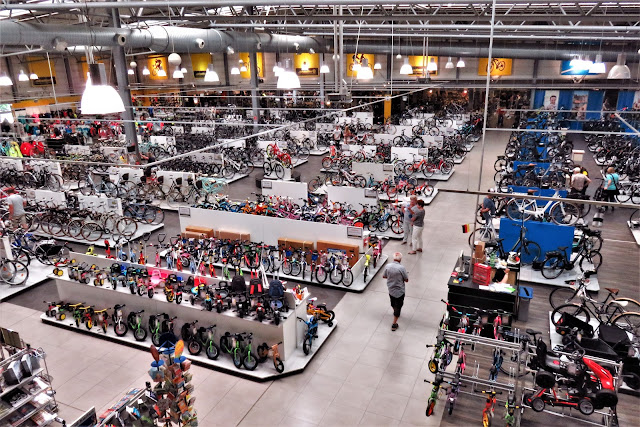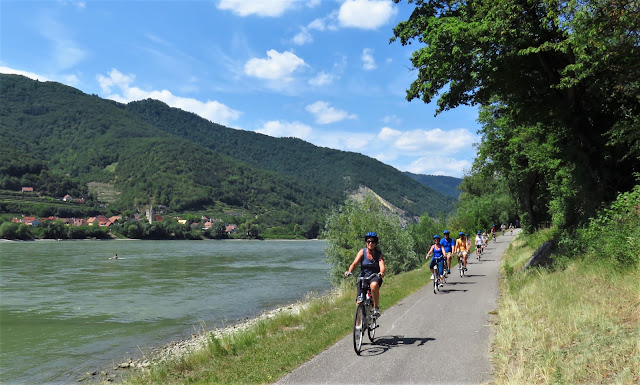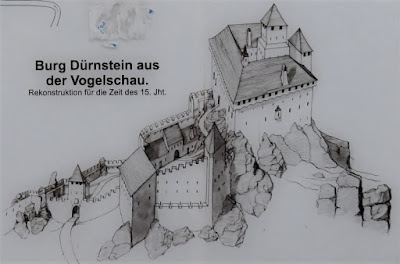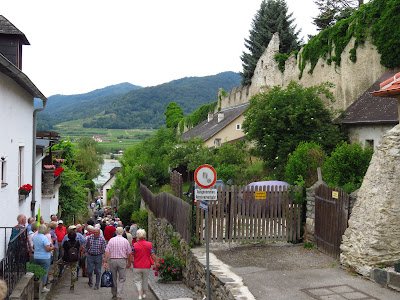
In our last post we took you 240 km from the source of the Danube, in or around Donaueschingen, to the city of Ulm. Last year we rode from Ulm to Passau and beyond, and found that section interesting but not quite interesting enough to repeat, so we hopped on a train to bypass it. However there were two doctors we wanted to meet midway, in Regensburg. No, nothing wrong with us, but the two doctors are the son and daughter-in-law of our German friends Rainer and Brigitte, with whom we rode for a few days last year on the Elbe, and with whom we will ride again in a few weeks when we are on the Rhine. We had been invited to lunch at the home of Stefan and Sabine, a special treat for us as we almost never have home-cooked food for lunch. Just as good as the cuisine was the conversation, in which we learned much about life in Germany and about practicing medicine in Germany from them. We would have liked to have gotten to know their two-year-old daughter Helene better, but she is at one of those super-shy stages, so we will just have to come back some day.


It was also a chance to stay for a second time at the very pleasant hotel we stayed at last year, the Muenchner Hof, down this narrow alley, and to explore the town again as well. This time we mostly wandered about, looking for interesting odds and ends, such as this massive bit of artwork on a building around the corner from our hotel, or those stony faces nearby. We also encountered a surprising plaque on yet another building on the same street, telling us that Oskar Schindler and his wife, of
Schindler's List fame, lived there for a time after the war.
We also used our train stopover in Regensburg to return to a bike shop we had been to last year, when we were in need of new tires. It has got to be the largest bike shop we have EVER been in. The photo only shows you about half of the store! While it didn't have the exact tires we wanted last year, it had the next-best choice. This time around it had exactly what Louise needed, new bike shorts to replace ones she had purchased just before we left Seattle, without trying them on first since it was a brand and style she had been using for years. Ooops, they changed the design! Don't you hate that when that happens to you? Take it from us, it's even more frustrating when you discover this several thousand miles from home!


We crossed the Danube on the train just before arriving in Regensburg, and it's still not overly large. Nonetheless, the bridge that was built there in the mid-1100s was a major engineering feat, and the only bridge over the Danube between Ulm and Vienna for centuries. Not surprisingly, it made Regensburg a major focal point of trade between southern and northern Europe, and consequently a wealthy place.
The bridge was being renovated last summer, and the renovations have progressed but are still not complete, as you can see on the left of the photo. The banks of the Danube are popular below the bridge for many tour boats and also river cruise ships. Above the bridge it was mostly just folks hangin' out, including a clatch of hookah enthusiasts.



Courtesy of the two 2-hour train trips, we had managed a quick look again at the Ulm minster, an evening poking around Regensburg, a morning poking around some more, then lunch with friends in Regensburg and dinner once again by ourselves in Passau. Sounds busy, but not really. We even had time and energy thanks to all that relaxing on the train to take an evening walk around Passau, which we had explored more extensively last year. Highlights were a lone river cruise ship on the Danube and, around the corner, a castle tower on the Inn River, which joins the Danube here. And a block away, Louise is showing us just how high the flood waters got in 2013 when we had to skip our plans to bike here -- it's the mark high up the wall next to the window, maybe
another 4m/12 feet above her hand! We would have needed that mini-submarine pictured in our last blog entry, in place of our tandem!
Come Monday morning, we were ready to begin our 335 km bike ride to Vienna. We were not alone. This is reputedly
the most popular bike route in Europe, and we saw large groups with obvious rental bikes and/or panniers with the name of this bike tour company or that. In Passau the night before we had in fact seen a dozen and a half bikes and their luggage van from an American outfit, Vermont Bicycle Touring! Louise actually did a trip with them over 20 years ago, in Vermont no less, before meeting up with and marrying her personal bike tour planner.

The routine for a large proportion of these bike tourists is to arrive in the evening and get fitted to a rental bike, have a group dinner, and set out the next morning for the first of seven days of cycling, rain or shine. The pluses are the arranged lodging, breakfasts and dinners and the carriage of your luggage, plus instructions on where to turn right or left and what to see. The distance is quite manageable, an average of less than 50 km/30 mi. per day, particularly given the fact that the route is almost totally flat and well-paved. As with most bike touring, there are those who go at their own pace either alone or in groups of 2 or 3, and those who go as part of a herd, such as a line of 20+ cyclists who came whizzing by in the opposite direction one day, or the bicycle ferry filled with bikes all bearing the same tour company name. And, yes, you can easily go in either direction. It's not exactly "uphill" going westbound since the elevation change is minimal, and the wind is not always out of the west, even though that is somewhat more common. But given the chance to end your special week of biking in a charming small city or in a major, magical metropolis, it's a tough choice but still no wonder that the vast majority of cyclists head eastwards, as we did, ending in Vienna.

Since we had ridden the first 2/3 of these 335 km last summer, we spent a little less time on sightseeing and more on just enjoying being out in this gorgeous scenery. We also decided to cover the distance in 6 days of biking, helped along in this decision by six days of dry weather in the high 70s and low 80s (~25-29 C). Anyone who has stumbled onto our blog for the first time who would like to see more detail from last summer's trip is invited to check out last summer's blog episode for this section at http://redtandem.blogspot.com/2016/09/danube-bike-route-ii-passau-to-durnstein.html, where you will see photos and commentary about some very special places, such as the Celtic museum, that we passed by this time around.
We had a sunny sendoff from Passau, and the houses along the Danube across from town shone in the morning sun. The sign of a good start, yes?

For all but a few kilometers, you can choose to ride on the north (left) or south (right) bank. The main considerations are the towns you go through -- which group of places look more interesting -- and how close or not you are to traffic. There are several bridges where you can switch from one side to the other, and also 5 or 6 dams. We crossed at one dam where we could actually bike across easily, but at least one other warned cyclists that they would have 90 steps to deal with if they
really wanted to cross there. We didn't, but Jeff ran up to check out the view and take this shot of a barge going through the locks adjacent to the dam.
Whichever side you are on, you
will see castles. However, it often turns out you can't really see them well without breaking out the binoculars or the telescopic lens on the camera.
We did get up close and personal with one castle, but before we got there we got a taste of a how the Austrians celebrate the state holiday of Corpus Christi. We were in the small city of Grein when the Stadtkapelle, or town band, marched past our window at 6 a.m., then returned an hour later after waking up every other person in town. (These folks were quite good, but they were NOT quiet).

They then headed over to the city center, where all the town officials and many of the town's citizens were gathered for a Roman Catholic mass in front of City Hall. The photo just above was taken the prior afternoon of the square in front of City Hall, and that's just where they were. Separation of church and state, you ask? What's that? Not in Austria!
Most of the town band stayed on to provide the musical accompaniment to the hymns, but these two fellows snuck away. Perhaps they were in the percussion section -- not too much need for them for that sort of music. Jeff came around quietly behind the congregation in the town square to observe and to take a shot of the colorful hats a small contingent of women were wearing for this festive occasion. We had observed in our last time in Austria as well that the locals really do love to get dressed up for special occasions like this.

We had spent the night in Grein last year, and you will find some lovely photos of the place in last year's blog entry. But we had failed on that occasion to visit one of Grein's claims to fame, the oldest public theater in Austria. There had been theaters created in the occasional palace or castle, but not one in the heart of a city that ordinary folks could go to. But in 1791 the city fathers converted one section of city hall into just that. It has several interesting features, but first let's take a look inside.
That curtain is one of those special things about the theater. It depicts Grein in 1791, and it still rolls up for performances to begin. Plays are still put on several times a year by a local community theater group, and the costume and prop shop is open to check out. Which Louise did.

The creators of the theater knew they needed steady customers, and figured out how to sell season tickets. The best seats in the house -- center, first several rows -- could be purchased for the season. But rather than print up tickets, they gave you a key! When you arrived, you put the key in the back of the chair and released the seat. After the performance, you raised the seat and locked it.
Plays can be long and folks sometimes need a rest room. Their solution here was equally unusual, and not nearly so wonderful. They installed a loo behind a curtain right on the side of the auditorium. You could use it during a play and not miss any of the performance. The playgoers nearby would likewise not miss any of your own performance.
Our next day was a long one, 77 km, but it brought us into the Wachau valley, full of castle ruins and vineyards climbing up the steep hills, particularly on the south-facing left bank.

The crown jewel of the Wachau is the town of Dürnstein and the ruins of Castle Dürnstein looming above it. This is where Richard the Lionhearted spent many lonely months in captivity, held for vengeance and for ransom by Duke Leopold V as Richard was making his way back to England from the Crusades. Seems Leopold had been "dissed" by Richard at the time of the conquest of Acre in the Holy Land, and Leopold saw this as a chance to get back at Richard and make some money on the side. Alas, the Pope excommunicated Leopold and, not long after, he fell off his horse and died.
We took the ferry across the Danube to spend the night at a comfortable hotel in the town with greenery and ancient ruins right outside our hotel room. After supper we checked out the city walls and looked up at the fortress. In the morning Jeff would scale its heights. Alas for Louise, she is nursing a sore knee and did not want to risk hurting it further and putting our hiking plans for England in a tenuous situation. Probably a good idea, as the climb was quite vigorous.
Right after breakfast, Jeff was on his way. It WAS steep, but the total climb wasn't long, only about 100m/325 feet above the town, which is 20m+ above the river. It didn't take much time, just energy, before Jeff was well above both.
After 25 minutes of climbing and pausing for photos and catching one's breath, he discovered three things: that he was near the top, that there was an alternative way down, and that the alternative way had no steps or rocks to maneuver over (or so said a fellow who had just come up that way). The adventure was looking better and better. It was also elucidated by a series of signs explaining why Richard happened to be imprisoned here, and what became of the various players in that drama. Yes, that
is Robin Hood, as Hollywood envisioned him in the 1930s, on one of the signs. Why, you ask? Because the legend of Robin Hood arose out of stories which alleged that John Lackland, Richard's younger brother and his regent while he was away on the Crusades (and then imprisoned here at Dürnstein) had become a tyrant. There is no proof Robin Hood ever actually existed, but an avenging do-gooder always makes for a compelling story.

A sign shows what the castle probably looked like in its heyday. There's not much of it any more after a few centuries of neglect, but the views are quite wonderful from up there, looking both upstream (the photo with the boat) and down.

Jeff was back down in time for us to be out of our hotel room by the 11 am deadline, and off we went, not following the crowds down to their river cruise boats, but rather following the Danube Bike Route signs and our guidebook to much less crowded scenes, such as these city streets that took us through Krems an der Donau, and the quiet country roads that swung below the massive Göttweig Abbey.
And then, the next day, we were in Vienna, beautiful Vienna. We'll do a short blog soon to show you some of the sights we saw during our 5-night stay, plus a few more shots we suspect of our train trip from one end of Austria to the other as we move on to the Rhine River. No, the Rhine does not go through Austria, but it does get very close -- less than 10 km -- to Feldkirch Austria, and that is where we head tomorrow morning on Railjet train #162.


